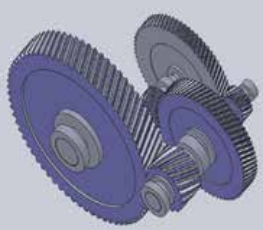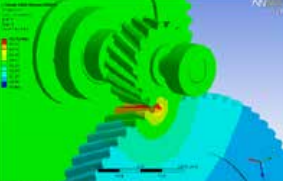Design and Thermal Analysis of Helical Gearbox
I. INTRODUCTION
Gears are the most common means of transmitting motion and power in the modern mechanical engineering world. They form vital elements of mechanisms in many machines such as automobiles, metal cutting machine tools, rolling mills and transmitting machinery. Toothed gears are used to change the speed and power ratio as well as direction between an input and output shaft. In helical gears, the leading edges of the teeth are not parallel to the axis of rotation, but are set at an angle. Since the gear is curved, this angling causes the tooth shape to be a segment of helix.
1.1 Finite Element Analysis (FEA)
It is widely accepted method of accessing product performance without the need for physical building and testing. It also shortens prototype development cycle times & facilitates quicker product launch. FEA consists of a computer model of a material or design that is loaded and analyzed for specific results. It is used in new product design, and existing product refinement.
1.1.1 Steps Required For Development of FEA Model
• Steps required for development of finite element model are as under:
• Assigning material and its properties to various parts.
• Discretize and choose element types.
• Choose a displacement function.
• Derive the element stiffness matrix and equations.
• Generate global or total equations from the element equations and introduce loads and boundary conditions.
• Solving for elementalstrains and stresses and interpretation of the model
1.2 Thermal Analysis
The thermal behavior of a system can cause a success from a bending and contact stress viewpoint into a failure from the resultant thermal operational characteristics like high operational temperatures, gear tooth scoring, and high drive system losses due to the high pitch line velocities. So it has to be carefully studied and analyzed.
II. METHODOLOGY
The design of the gearbox is done by using the empirical formulas, from which the basic dimensions and geometry of the gearbox are achieved.
Input parameters are:
Power: 37 kW
Input rpm: 1500
Output rpm: 25
Now the model is generated in “Solidworks” with ISO standard. The model is generated by extrude and revolve command of the software. In part modelling firstly the dimensioning system is designed for ease in modelling, after that the each part is made separately and are assembled later to get the full gearbox model.
To analyze the model we have to done its finite element analysis to get the temperature generated on the teeth of the mating gears.For this firstly I have taken the simplified model of the gearbox having only the gears, shafts and bearings. Then the model is imported to the ansys workbench where all the contacts are defined and the meshing is done. Now the static structural analysis is done to apply the rotational velocity and the fixed support of the bearings and the tangential force due to the meshing of the gear. Now the steady state thermal module is selected and the data of structural analysis is imported to the module and convection coefficient due to the lubricant is applied and the results of the temperature generated at the contact of the driven and driver gear is achieved.
Boundary conditions applied:
1. Fixed support applied on bearings
2. Rotational velocity at the input gear
3. Tangential force due to the meshing of the gears
4. Convection due to the lubricant
III. RESULTS AND DISCUSSIONS
Thermal analysis at no load condition

The temperature generated at no load condition is 45.3520C

Thermal analysis at loading conditions:

The temperature generated is 101.190C

IV. CONCLSION
In the study of designing the gear box by analytical method with input power of 37 KW, input speed 1500 rpm, it is concluded that with the module of 5 and 8 mm all the stresses are within the safe limits. So the design of gearbox is safe. The heat generated while functioning of the gearbox is found to be 101.190 C, which is not within permissible limit, therefore, further computational fluid dynamics analysis can be done and find necessary solution using these methods to reduce the temperature.
